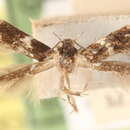Comprehensive Description
(
الإنجليزية
)
المقدمة من Memoirs of the American Entomological Society
Elachista leucofrons Braun (Figs. 17, 36, 84, 126, 126a.)
1920. Elachista leucofrons Braun, Ohio Journ. Sci., xx, 170. Type S, Cincinnati, Ohio [A. F. B. Coll.].
1921. Elachista leucofrons Braun, Ohio Journ. Sci., xxi, 209.
1923. Aphclosctia leucofrons Forbes, Mem. 68, Cornell Univ. Agric. Exp. Sta., p. 222.
Head blackish, slightly irrorated, with a creamy white patch across the face below base of antennae, sometimes covering the whole face below the antennae ; palpi black below and at extreme apex, white above, the white completely encircling the base of the third segment and tip of the second; antennae gray, with pale annulations which become white and more conspicuous toward tip in female. Thorax blackish, with tips of tegulae white; fore wings blackish, slightly irrorated, the irroration sometimes forming faint whitish lines of which two, one below and one above the fold and parallel with it, are most often discernible. Wing from extreme base of costa across to dorsum narrowly white; an irregular narrow white fascia just beyond one-third, oblique in its costal half, nearly perpendicular in its dorsal half; an erect narrow white spot at tornus, and nearer apex, a similar costal spot, sometimes nearly obsolete ; a row of black-tipped scales at base of the grayish black cilia. Hind wings and cilia dark blackish brown. Legs except femora blackish, with tips of all segments and basal half of hind tibiae, whitish. Abdomen blackish brown above, entire body silvery beneath, with a yellowish tinge.
Alar expanse : 9 to 10 mm.
Male genitalia (fig. 84): gnathos rounded; harpes exceeding the uncus, sacculus processes more slender than in irrorata; anellus lobes truncate; vinculum broadly rounded and bluntly produced anteriorly; vesica armed with a heavy blunt spine and a cluster of one longer and several shorter sharp spines. Female genitalia (figs. 126, 126a) : dilated portion of ductus bursae before ostium tub-shaped, preceded by a weakly sclerotized band, which in turn is preceded by a more strongly sclerotized segment, extending anteriorly to the middle of segment 7. At the inception of the ductus seminalis in segment 7, the ductus bursae bears two blunt teeth. Bursa copulatrix bilobed, and densely spiculate; signum a strongly sclerotized rather broad dentate band.
Specimens examined: 22 $ , 13 9.
Ohio: Cincinnati, 6 type, imago, May 12, 1919; 4 <J paratypes [A. F. B. Coll.], 1 6 paratype [A. N. S. P.], under rearing record B.1002, with dates of emergence from May 3 to May 9, 1919; 12 S , 7 9 , under rearing record B.1031, with dates of emergence from May 19 to May 27, 1920 [A. F. B. Coll.] ; 1 9, same data [A. N. S. P.] ; 1 6, "on Elymus," imago, V.5 ; 2 5,2 9, under rearing record B.2033, imagoes from May 3 to May 11, 1943; one S flown specimen, May 23, 1903 [A. F. B. Coll.].
North Carolina: Black Mts., 1 2 without abdomen, VI, 17 [U. S. N. M.].
Colorado : Alpine Lodge, Sangre de Cristo Mts., altitude 8800 feet, 1 9 without abdomen, VII-16-1934 [A. F. B. Coll.].
New Mexico: Pecos Nat'l For., Alt. 10,000', 1 9, Aug. 24, 1916 (C. Heinrich), [U. S. N. M.].
In the New Mexico specimen the extent of white is increased, with confluence of the pair of spots at two-thirds the wing length, but the genitalia indicate its position here.
The larvae mine leaves of wild rye, Elymus canadensis L. and E. virginicus L., and less commonly leaves of Hystrix. The large whitish mine on Elymus starts near the tip of the leaf, extending downward and broadening to the width of the leaf; it lies just beneath the upper epidermis, and the tissue adjacent to the lower epidermis is not eaten, so that the under surface of the leaf remains green. The larva is pale grayish or greenish, with a narrow mid-dorsal and broad lateral lines whitish ; prothoracic shield marked posteriorly by a transverse brownish mark, curving forward at each end.
The pupa (fig. 36) is not enclosed in a cocoon but lies close against the leaf, attached by anal end and median silken girdle; dull yellowish gray, elongate, with prominent dorsal and lateral ridges, mesothorax with low rounded tubercles and characteristic sculpture, small tubercles on front of head.
The species is apparently single-brooded. Mines were collected in the latter part of March and early April, and it is probable that the larvae had begun to mine during the preceding autumn.
The species is separated from albicapitella (its nearest ally) by the peculiar markings of the palpi, the creamy white face, with absence of white on the crown, and the duller white wing markings.
- الاقتباس الببليوغرافي
- Braun, A.F. 1948. Elachistidae of North America (Microlepidoptera). Memoirs of the American Entomological Society vol. 13. Philadelphia, USA

